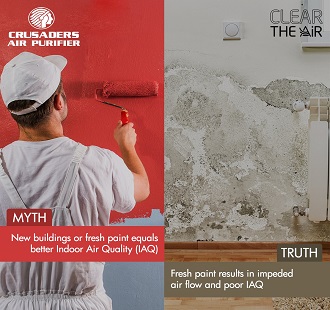
Those who live in cities spend up to 90% of their time indoors. Unfortunately, the air they breathe inside their homes is similar to outdoor air in terms of quality, especially in well-ventilated buildings. There is even a phenomenon known as sick-building syndrome, where simply spending time in environment having air pollution and can cause symptoms of sickness.
When we think of air pollution, we tend to think of car exhausts or factory fumes expelling gray smoke. There are actually more sources of pollution that have a negative effect on air quality inside our homes and offices. Due to the presence of cooking residue, paints, varnishes and fungal spores, the air we breathe indoors is often more polluted than that outside.
Today, concerns about indoor air quality in developed countries have found expression in green building guidelines, smoking bans and product standards. The problem still persists because of faulty construction, infrequent maintenance and untested product formulas. Increased time spent indoors causes increased personal exposure to many compounds originating indoors. Residential environments have the potential to be critical sources of pollutants, thanks to building materials, household furnishings and a wide range of consumer products.
Indoor sources include malfunctioning HVAC systems, emissions from office equipments, new carpets in homes that release formaldehyde, burnt Teflon pans, dust-attracting or water-damaged materials, unsanitary trash emissions, pests, food preparation areas, cleaning materials, pets and smoking. Common outdoor air pollutants that manage to enter our living space include smog, bacteria, mold spores, vehicle exhaust, exhaust fumes, pollen, dust, algae from standing water and smoke. Even garbage and other household products release VOCs to the air that wreak havoc on the ozone layer.
Do air purifiers really work to control indoor air pollution?
The air pollution levels inside a room can be up to three times more than what it is outdoors, mainly because of dust, cooking fumes, incense sticks, and dead skin from humans or pets, to name a few.
Most consumers doubt the usefulness of an air purifier, because the appliance seems to just sit in a corner and silently blow air. But one look at the filter would convince the naysayers otherwise. If not for that filter, all the dust would be inside your lungs.
With Diwali fast approaching, are you adopting measures to celebrate in good health?
Crusaders provides Indian households quality air purifiers with 7-layer filtration that keeps your immediate environment clean in the most effective way, ultimately providing an atmosphere free of allergens, smoke, dust, pollen and harmful chemicals. These air purifiers come with HEPA filters composed of fiberglass, which remove at least 99.97% of airborne particles.
Check out our range of products today and have a healthy Diwali.
For latest updates and information, visit our Facebook Page.